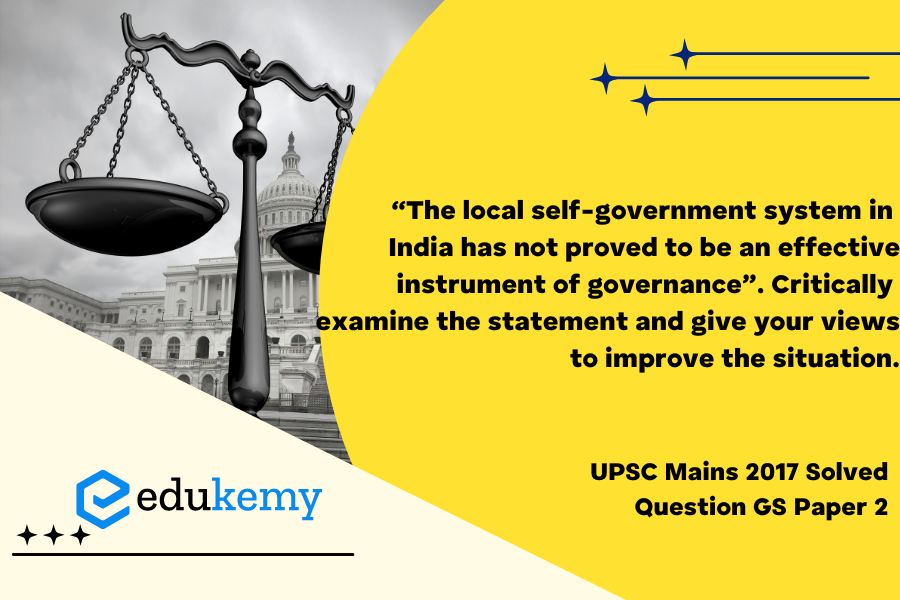The local self-government system in India, designed to empower grassroots democracy and foster effective governance, has been a subject of critical evaluation. While it was envisioned as a powerful instrument to decentralize authority and address local issues efficiently, its practical effectiveness has often fallen short of expectations. The system grapples with challenges such as political interference, inadequate financial autonomy, and a lack of capacity-building at the local level. Corruption and bureaucratic hurdles further impede its functionality. To improve this situation, it is imperative to enhance the financial independence of local bodies, ensuring they have the resources needed for independent decision-making. Simultaneously, there should be a concerted effort to strengthen local administrative capabilities through training programs. Additionally, measures to curb political interference and promote transparent, accountable governance must be implemented to realize the true potential of the local self-government system in India.
Tag: Indian Constitution- Devolution of powers and finances up to local government level.
Contents
Decoding the Question:
- In Introduction, briefly write about local self-government- mention Constitutional provisions and the role of government at the local level.
- In Body,
- Discuss various issues and success of local self-government.
- Suggest various measures to improve the situation.
- Conclude by writing about the overall significance of local self-government and mention various committees related to it.
Answer:
The Panchayati Raj Institutions(PRIs) were formed after 73rd amendment to the constitution of India on the recommendations of the LM Singhvi Committee, giving effect to the Article 40 in the Directive principles in the constitution for effective local government in 1991.t is a prime instrument of decentralization through which democracy becomes truly representative and responsive for effective governance.
Local self-government system as an effective instrument of governance:
- Representation and Participative democracy: Through the mechanisms of local election and decision reviews at Gram Sabha level, democracy strengthens.
- Policy Formulation and Implementation: Various Central and state government schemes are implemented through Panchayats; It also plays a role of governance at local level.
- Reducing distance from the government: The local representatives are reachable in regular Gram Sabhas.
- Empowering Vulnerable sections: India’s PRI system provides reservation for Women, SC and ST.
- Transparency: The Gram Sabha is a mechanism of Social Audit. It reviews expenditure of the Panchayats and holds them accountable.
- Decentralization of power: The power reaches near the government and through social audits in the hands of the people themselves.
- Effective public service delivery as per the needs of the local population through LSG allows for a bottom-up approach. Example- MGNREGA.

Challenges:
- Conceptual confusion: There is also no clarity about the relationship between local governments and the other administrative organizations and not considered as a part of institutional framework for the development of masses.
- Lack of funds: The resource is based on the local economy and partly upon the allocations made by the state and central governments. The recommendations of the State Finance Commission are also not binding in nature.
- Functions: There are very little or no functions and authority. It is also violated and distorted in most States by parallel bodies. Ex: States like Punjab, Haryana and Rajasthan abolished local taxes.
- Functionaries: Lack of adequate staff and capacity building.
- Power Sharing or Shedding: The involvement of MPs and MLAs in the functioning of the Panchayat can create conflict between them and Panchayat leaders.
Measures to improve the situation:
- Clear definition of functions for each level of local government in case of each subject matter.
- State Finance Commissions should evolve objective and transparent norms for devolution and distribution of funds.
- Capacity building efforts must attend to both the organization building requirements as also the professional and skills upgradation of individuals associated with these bodies.
- Putting in place a well-delineated activity mapping for Local Self Governance.
Despite limitations, the local self-government system is the “tool of democratic seed drilling in the Indian soil”, which helps the people in governing their own affairs in villages. With the implementations of recommendations of 2nd ARC Commission and National Commission to review the working of the Constitution (NCRWC), we can take root in the habits and hearts of the people which is instrumental to ushering in an inclusive and just society. Even though the ideas are not completely fulfilled with the local self-government, its effectiveness cannot be undermined, especially due to the governance structure in rural areas.
In case you still have your doubts, contact us on 9811333901.
For UPSC Prelims Resources, Click here
For Daily Updates and Study Material:
Join our Telegram Channel – Edukemy for IAS
- 1. Learn through Videos – here
- 2. Be Exam Ready by Practicing Daily MCQs – here
- 3. Daily Newsletter – Get all your Current Affairs Covered – here
- 4. Mains Answer Writing Practice – here


